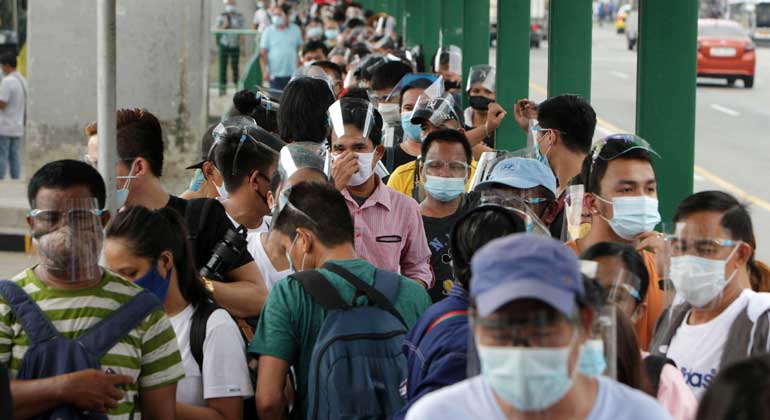
PEOPLE in Philippine cities have moved more freely after lockdown restrictions were eased, matching a fresh surge in coronavirus infections, according to an Asian Development Bank (ADB) blog.
“Mobility undoubtedly plays a significant role in both the spread and containment of the virus,” according to the blog posted on the ADB website on Monday.
It cited a link between increased traffic jams in Metro Manila and the rising tally of coronavirus infections in the region.
The blog was written by Thinking Machines Chief Executive Officer and lead data scientist Stephanie Sy, along with ADB officials Hanif Rahemtulla and Bruno Carrasco.
Vehicle traffic across Metro Manila, Cebu City and Davao City dropped by 94% between March and May, when many parts of the country were locked down to contain the pandemic, the authors said, citing data from the Waze app.
“We observed that for some of the most congested roads in Metro Manila, traffic flow in July came close to the previous year’s traffic patterns, with some roads only 6% away from previous levels,” the authors said.
“At the road level, we see that although traffic flow dropped in during the strictest restrictions, it began to rise quickly as they were eased, similar to municipality- and city-level patterns in Metro Manila,” they added.
Davao City continued to restrict people’s movement, “and we don’t see a rise in travel as we do across Metro Manila,” according to the ADB blog. Throughout July, people in Davao City were still under a curfew and trips outside for essential shopping were only allowed on certain days of the week and required the use of passes.
On the other hand, Cebu City experienced spikes in COVID-19 (coronavirus disease 2019) cases in June even if mobility remained extremely low, the authors said. “What else could be at play here in the rise of cases? News sources have reported that the epicenter of cases is the Cebu City Jail. This points to the need to consider other factors beyond mobility, including social distancing measures, sanitation and hygiene protocols, testing capacity and access to healthcare services and facilities.”
Metro Manila residents visited groceries and pharmacies more than any other destination outside their homes, followed by workplaces, according to the blog, citing Google mobility data.
“As restrictions ease, businesses are reopening, and people are returning to their regular office hours,” it said. People had avoided recreational destinations such as parks, retail locations and public transport stations from June to July, it added.
Forecast notes from University of the Philippines researchers showed that the average coronavirus infections in the country had risen to 900 per day in the past two weeks of June and to more than 2,000 daily at the start of July, from the less than 500 new cases daily in May.
The strictest form of lockdown has been implemented for most of the country until May, while restrictions have been slowly eased starting June.
Acting Socioeconomic Planning Secretary Karl Kendrick T. Chua earlier warned that recent improvements in economic data such as in external trade “can easily be reversed” if strict lockdowns were imposed again.
The country’s external trade deficit grew to its widest level in five months at $2.076 billion in August.
A SEAT APART
Meanwhile, Cabinet members have approved a plan to allow commuters to sit a seat apart in public transportation to increase capacity, presidential spokesman Harry L. Roque told an online news briefing. The distance may be lowered until commuters can sit next to each other as long as there is a plastic barrier between them, he said.
Rail capacity will be increased to as much as 50%, while provincial buses, motorcycle taxis, ride-hailing services and shuttles will be expanded, he added. Cabinet officials also approved a plan to fast-track service contracting to expand buses and jeepneys.
Mr. Roque said the seven commandments in public transportation recommended by health experts should be enforced strictly to reduce the risk of infection.
These are wearing face masks and shields, no talking, no eating, adequate ventilation, frequent and proper disinfection, no passengers with symptoms and physical distancing.
Also on Tuesday, the Land Transportation Franchising and Regulatory Board (LTFRB) said it has added more routes and allowed more jeepneys to operate in Metro Manila.
The agency opened 44 more routes on Oct. 10 and allowed 4,820 more traditional jeepneys to operate in the capital region.
The number of traditional jeepneys allowed to operate in the metro amid a coronavirus pandemic rose to 27,016, it said in a statement.
There were now 302 routes for jeepneys in Metro Manila, which is still under a general lockdown. The LTFRB said 845 modern jeepneys had also been allowed to operate in 48 routes.
It had also allowed 4,016 bus units and 387 point-to-point buses to operate in 34 routes, and 3,263 UV Express in 76 routes.
The transport agency said 20, 927 taxis and 24,356 ride-hailing cars operate in Metro Manila.
It added that more than 280 provincial buses have been allowed to operate in 12 routes while 40 modern UV Express vehicles were allowed in two routes. — Beatrice M. Laforga, Vann Marlo M. Villegas and Arjay L. Balinbin
